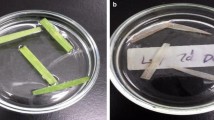Abstract
The early stages in the infection process between Frankia and the roots of its host plants are poorly understood. At present, there is relatively little known about the infection process in plants after the initial stage of root hair curling, but before a nodule may be visualised by eye. This paper presents a novel method of screening plant-microbe interactions, which is non-lethal to the plant, on the basis of a change in the autofluorescent pattern in the plant’s root system when viewed using fluorescent microscopy with an excitation wavelength of 490 nm.
Similar content being viewed by others
Author information
Authors and Affiliations
Corresponding author
Rights and permissions
About this article
Cite this article
McEwan, N.R. Autofluorescence as a diagnostic tool for the infection of alders by Frankia. Sci Soils 5, 22–27 (2000). https://doi.org/10.1007/s10112-000-0003-2
Received:
Accepted:
Issue Date:
DOI: https://doi.org/10.1007/s10112-000-0003-2




